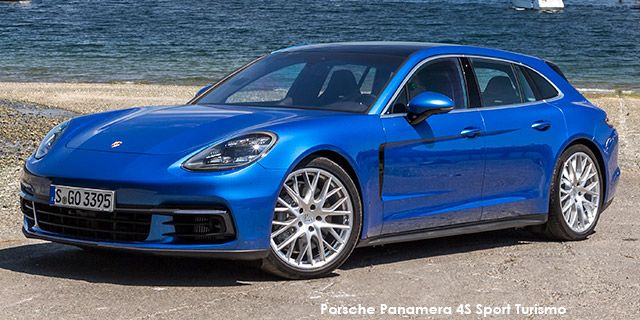Porsche tweaks the Panamera to offer an interesting alternative to its Cayenne SUV...
It’s not often you look at a car and think, “Wait… what is that exactly?” We’re not talking about the brand – even from a distance, it’s clear you’re looking at one of Zuffenhausen’s finest – but the kind of car. The extended roofline and rear hatch clearly indicate this is not a sedan but neither is it quite station-wagon-esque in silhouette. It certainly doesn’t offer the kind of the interior volume that any of the German premium-segment estates provide. And, whereas it may mimic a shooting brake’s sports-coupé-with-an-extended-roofline persona, this Porsche has four doors, unlike the classic shooting brake’s two.
Irrespective of the difficulty you may have in defining this Porsche, there can be no doubt that this is the best-looking Panamera in the range. As much as the second-generation Panamera is a far more resolved design than its rather stodgy forbearer, the Sports Turismo derivative’s elongated profile with its thicker D-pillars, less angled rear window and roof spoiler give it a more youthful character and a charisma the conventional model lacks.
But looks alone aren’t what Porsche AG is banking on selling the Sport Turismo. What, then, does that extra space buy you? The ST shares the same length and wheelbase as its short-wheelbase sibling but, from the B-pillar backwards, it’s all-new sheet metal that includes a longer and higher roof, rear doors that open wider and a hatch that offers a loading height 146 mm lower. The boot also offers a wider loading aperture that adds to the lower lip’s practicality.
As opposed to the fastback’s two, the ST offers seating for three rear passengers, although the person in the middle isn’t going to have the most comfortable experience with legs splayed by the transmission tunnel. Porsche call it a four-plus-one layout. Whereas rear legroom is generous in the Panamera, taller passengers might’ve felt the D-pillar lining brush against expensive haircuts; the ST’s additional 98 mm of headroom should make all but the most bouffant feel at ease.
Luggage space, however, isn’t quite as generous as you’d think. While our measurements indicate an acceptable increase in utility space with the rear seats folded (816 versus 1 152 litres), the ST offers only 24 litres of extra boot space with them in place.
Being a Porsche, though, there’s no questioning the interior quality. Not flashy and heavy on the chrome detailing as some luxury vehicles are, it’s tastefully modern and superbly screwed together with a high-tech dashboard dominated by the infotainment system’s 12,3-inch screen, supplemented by a pair of configurable 7,0-inch screens either side of an analogue rev counter.
Our press car’s interior came fitted with some choice options and these included a leather interior package (R61 080; partial leather is standard); a panoramic glass roof (R36 160); and surround-view cameras (R24 330) that supplement the park-assist system. In terms of functionality, the standard-equipment list includes a rain sensor, electrically folding and automatically dimming exterior mirrors, as well as an electrically opening and closing tailgate. Notable, too, are all the doors’ stepless positioning; instead of opening to defined positions, as is normally the case, the doors are held at the exact angle at which they were opened, providing protection against car parking damage.
Behind the wheel, eight-way power-adjustable and heated seats, along with an electrically adjustable steering wheel, allow you to quickly find an ergonomically comfortable driving position. Turning the ignition nub fires up the new twin-turbo V6 that has its blowers fitted within the V of the engine block. It’s also an engine featured in the new Cayenne and, coupled with an eight-speed dual-clutch transmission, the 324 kW/550 N.m powerplant certainly provides quick progress, with 100 km/h flashing past in 4,07 seconds.
Despite being a large car, at speed the Sport Turismo feels a lot more nimble than it ought to. That’s thanks mainly to the optional rear-axle steering system that results in increased agility in slower corners, where the rear wheels turn in the opposite direction to the fronts up to a maximum steering angle of 2,8 degrees and at speeds of up to 50 km/h.
High-speed stability, meanwhile, gets a boost by the wheels turning in the same direction as the fronts, creating a virtual wheelbase extension. The system also features Porsche’s Power Steering Plus speed-sensitive power-steering system that firms up at high speeds and adjusts the steering ratio for easier low-speed manoeuvring and parking. At those speeds, as one of our testers noted, it can feel a little odd as the ratio suddenly tightens up.
TEST SUMMARY
Given its hard-to-define body style, you could criticise the ST for being something of an in-betweener and lacking out-and-out punch of a vehicle such as an Audi RS6. Within the brand's line-up, it's pricey, too; you can get a roomier Cayenne S with the same drivetrain for much less.
That didn't seem to bother the CAR team, though, and our notes were focused on the positives of the ST's silhouette, the superb fit and finish, and precisely tuned ride that, thanks to the standard three-chamber air suspension, is controlled and supple.
*From the July 2018 issue of CAR magazine
ROAD TEST SCORE

|
Original article from Car











